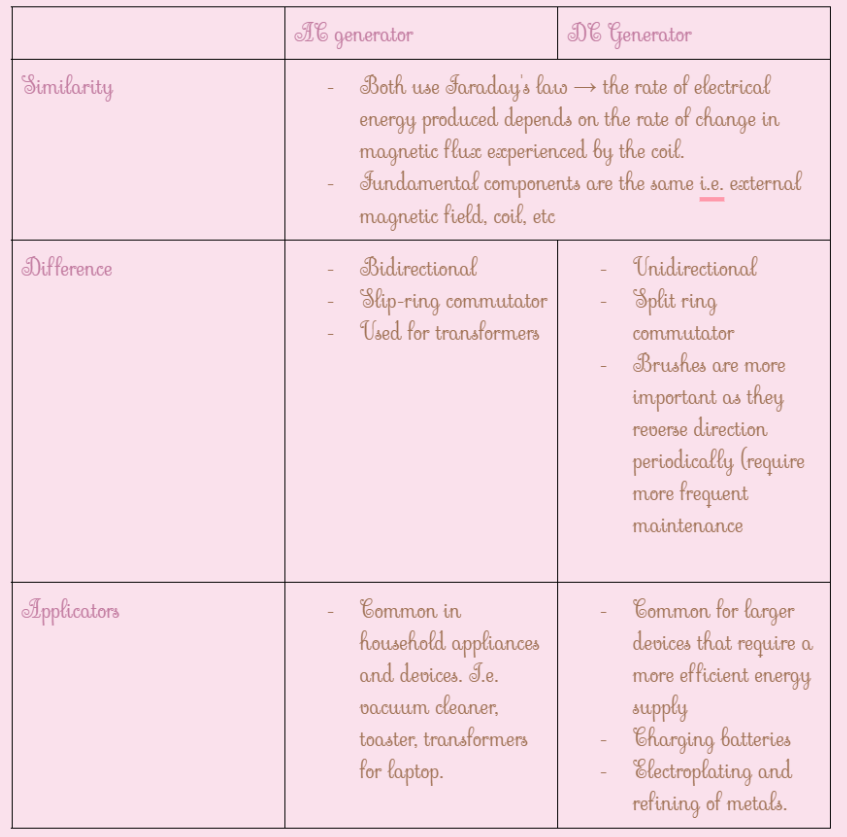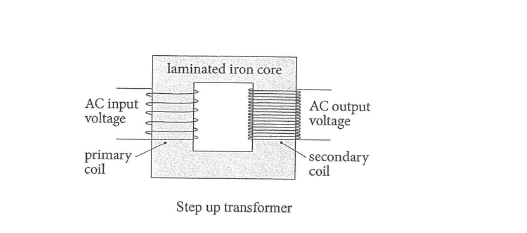Physics - mod 6: electromagnetism
1/50
There's no tags or description
Looks like no tags are added yet.
Name | Mastery | Learn | Test | Matching | Spaced |
|---|
No study sessions yet.
51 Terms
Properties of an electric field
never intersect
perpendicular to the surface of the charge
magnitude of charge and the no. of field lines are proportional.
Uniform electric field formula
E = V.d.

Force in an electric field
Stationary
F = Eq
W = Eq*d
Coming in from the side
KE = W = 1/2mv2
1/2mv2 = qEd
Charges in mag. field - concept
Any moving charge has a magnetic field associated with it. A moving stream of electrons will experience a force inside a magnetic field.
Why?
= The stream of charged particles has its own magnetic field which interacts with the external magnetic field.
External magnetic field formula
F=bvqsintheta
Charges in magnetic field - pathways
The force on a charged particle in a magnetic field always at right angles to the velocity of the charged particles. This creates circular motion
R=mv/qb
Electric vs. magnetic field
Similarities and differences

Motor effect
A current carrying conductor in the presence of a magnetic field will experience a force
F = BILsintheta
Motor effect - variable changes the size of the force
Voltage
Variable —> changes direction of force of wire in magnetic field
Polarity of magnetic wire + direction of flow of positive charge relative to B.
Force between wires

Ampere + Newton’s third law of force between 2 wires
Ampere = the constant current which if maintained in two straight parallel conductors would produce between those conductor a force equal to 2×10-7Nm-1 length
Newton’s third law = if one wire applies a force to a second wire, the second wire will apply a force that is equal in magnitude and opposite in direction on the first wire.
DC Motor - definition + formulas
A device that transforms electrical potential energy into rotational KE through the application of a DC current
T = F.d
F = B.I.L
T = nIABsintheta
Components of a DC motor
Split ring commutator = reverses the direction of current every 180 ensuring continuous turning occurs.
Magnet = provides an external magnetic field in which the coil rotates
Axle = provides a point of rotation for the armature. Transfers the rotational energy to another appliance
Coil = carries current to produce mechanical energy
Brush = acts as a conductive connection between SRC, armature, & power supply
Battery = provides current
Two ways the efficiency of the motor can be improved:
Why electromagnets
Reduce friction + add more coils
To turn motor off + control its strength
Magnetic flux definition and formula
The measure of total magnetic field lines in a set area.

Magnetic flux density definition
Is a measure of how densely packed the flux lines are. (T)
Faraday’s law definition + formula
Faraday determined that the size of the EMF that is generated is proportional to the rate at which flux is cut. For EMF to be generated there must be relative movement between conductor and magnetic field.

Lenz’s law
Emf generated by cutting flux will generate a current flow if a complete circuit is provided. When current is generated it will create a magnetic field that opposes the change.
Faraday’s law says that “cutting flux leads to voltage.” Electrical law says “but voltage only leads
Explain how a voltage is produced when the magnet is dropped into the coil?
When magnetic flux lines are cut by a conductor, the charges in the wire conductor experiences a force.
(Internal interacting with external magnetic field).
Steps in Lenz’s law
EMF produced by cutting flux
EMF drives current
The current flowing creates its own magnetic field. This magnet will oppose the magnetic field.
Torque
Turning effect of a force
Back EMF
A motor has an applied EMF which drives current through coil. As the motor starts to spin the armature starts to cut flux. This means that the motor unintentionally acts as a generator. The EMF generated always opposes the applied EMF, due to Lenz’s law,
Lenz’s law and conservation of energy
Ensure that the induced current’s energy comes from the work done against the opposing force.
Eddy current’s role in magnetic breaking
Generate their own opposing magnetic field, resisting motion
Kinetic energy convert to heat, slowing the object.
Magnet falling through copper wire
Eddy current: as magnet falls, its changing field induces eddy current in pipes.
Opposing force: These magnet create a mag. field that opposes the magnet’s motion
Energy loss: kinetic energy is dissipated as heat, reducing net acceleration S
AC induction motor
An AC induction motor is an electric motor where torque is generated by current induced in the rotor via electromagnetic interaction with the stator’s rotating magnetic field.
The stator’s AC-powered windings produce a rotating magnetic field.
This changing field induces a current in the rotor conductors (Faraday’s law).
The rotor’s current creates its own magnetic field, which opposes the stator’s field (Lenz’s law), producing torque.
Stator =
a series of wire coils wound on soft iron cores that surround the rotor.
produce an apparent rotating magnetic field
Rotor
comprises a series of conductors (metal bars) and the rotor rotates about the axis of the motor’s shaft.
Carrying large induced currents embedded in the surface of the armature.
Steps in AC induction motor
AC is supplied to the stator - the surrounding electromagnet
produces an oscillating mag. field
induces a current in the rotor
turns the rotor into an electromagnet
tries to oppose the stator field being generated (Lenz’s law)
stator and rotor push against each other (mag. field)
cause the rotor to return
Transformers
Simple devices that allow us to use an input voltage and make it into output voltage that is larger or smaller depending on the need. Ste
Step-up transformer
When the no. of coils in the secondary coil is larger
Step-down transformer
When the no. of turns in secondary is less than primary A
Primary coil - transformer
Receives an input voltage and induces a changing mag. field
Secondary coil - transformer
Produces a voltage based on the turn’s ratio, enabling efficient voltage transformation for electricity distribution
Soft core - transformer
Reduce eddy current loss and provide a low reluctance path for flux current.
Two applications in tansformer
Microwave ovens: step-up transformers increase the voltage to power the magnetron
Doorbell systems: step-down transformers reduce voltage for safe operation of the doorbell circuit.
Why is AC current required for the function of a transformer
AC— constant changing current
Creates a changing mag. field to induce a voltage in the secondary coil
Linkage between transformers + law of conservation of energy
Transformers uphold the law of conservation of energy by transferring electrical energy from one circuit to another with minimal loss. I
Ideal transformers
Would have no energy loss, meaning the energy output would exactly equal the energy input. However, real-world transformers always have some losses, making them less than 100% efficient.
Eddy current
Are spiral shaped currents that form within electrical conductors when they are placed inside a changing magnetic field.
Limitations of transformers

Force vs torque graph in motor

EMF graph between DC and AC generators
the emf is zero when the normal of the coil is perpendicular to the magnets

Why is a slip ring used in an AC generator
The current is already AC, so there is no need to reverse the current direction with a split ring.
A slip ring is used to preserve the AC current. Slip rings remain in contact with the brushes throughout the entire 360 rotation.
AC vs. DC generator

Transformer diagram

Purpose of split ring commutator in DC and AC generator
Continuous rotation is provided by the external driving force
split ring = keeps output current direction constant.
Torque produced by a DC motor with radial magnets
The plane of the coil in all positions remains parallel to the direction of the magnetic field.
Steadier torque

ideal vs non-ideal motor graph
EMF
Output torque on axle
Net torque on axle

What does increasing the speed of rotation do to the generated induced EMF?
Increases amplitude and frequency